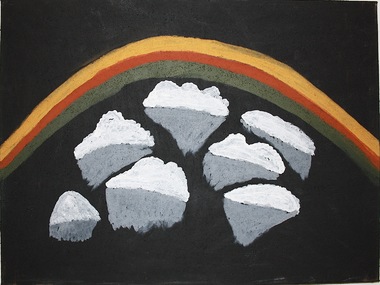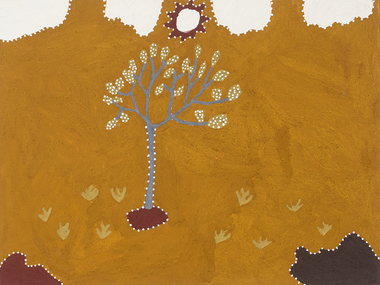WARMUN ALL OVER

'Tharriyarrel' (Rainbow) by Mabel Juli - the scat that stopped the rain
Posted by Jeremy Eccles | 18.09.13
Dates:
29.08.00
: 21.09.00
Location: CrossArt Projects, off McLeay St, Kings Cross, Sydney
Suddenly the artists of Warmun in the East Kimberley are all over the place. With wins for Mabel Juli at the RAKAs in Melbourne and Churchill Cann at the WA Indigenous Art Awards, Lena Nyadbi starring on the roof of the Musee du Quai Branly in Paris, some lovely old Queenie McKenzies turning up in Sydney, even some Rover Thomas at the new Sydney Contemporary Artfair, and Phyllis Thomas and Peggy Patrick in tandem at Vivien Anderson's gallery in Melbourne, it feels as though the dreadful flood of March 2011 which made refugees of most of the artists as their homes and art centre were washed away, have been put well behind the community.
But most intriguing of all is the current show at Cross Art Projects in Sydney's Kings Cross. This one will get right up the noses of our incoming government in Canberra, for it involves an academic grant for the National Climate Change Adaptation Research Facility (soon to be disbanded, I imagine) regarding Indigenous perceptions of climate change (which has already been denied!). And the artists of Warmun come in through their paintings – all of which discuss the ways in which seasonal weather changes impinge upon the plants and animals around them in the three key seasons of Kimberley life – the hot (Barnden), the wet (Jadagen) and the cold (Warnkan).
Well, actually, it's the other way round up there! The weather doesn't cause the changes; “it's induced by the behaviour of humans, animals and plants”. In other words, when the bauhinia tree's leaves begin to fall and masses of honey-laden red flowers appear, it's telling Barnden to start. And the consequence is that flying foxes come for the flowers, goannas have to get up on to their toe-nails to walk around on the hot ground, and delicious sugar-leaf lerps gather on the leaves of some Eucalypt species, ripe for the plucking. And when the reddish-coloured blue-tongue lizard lifts his tail to excrete the red, green and yellow substances that become the rainbow across the sky, it's telling the rain to stop and Jadagen to come to an end.
Sonia Leonard, the academic who's been studying these perceptions over the last couple of years, reckons that this faith in myth and legend informed by millennia of observation and a build-up of encyclopedic knowledge reveal “a deep spiritual connection to 'Country' that Gija people have (which) means that any alterations to the environment from climate change has profound personal and cultural meaning”.
Frances Kofod, the region's pre-eminent linguist mitigates that somewhat by pointing out that the Gija have already had to adapt to ice-ages and drought and a fundamental change in the Kimberley ecology from forests to savannah – not to mention their more recent toleration of an invasion that destroyed water-holes and springs thanks to the unwelcome arrival of cattle. And, ironically, it was the extreme weather event known as Cyclone Tracy which lead directly to the death of a woman who appeared in the dreams of one Rover Thomas which caused the need for painted dance boards to accompany his Goorirr Goorirr ceremony that has resulted in an East Kimberley painting movement.
NB here: Rover's ceremony was once commonly transliterated as Krill Krill – which caused the much amusement. Ms Kofod is now clear that both they and the orthographers are much happier with the form, Goorirr Goorirr – and I accept her advice.
Oddly, the informative catalogue for this exhibition/project only seems to include two examples of climate change noted by the observant Gija. That flood which knocked out Warmun - “it didn't come along to us slowly like before”, says Mabel Juli. “It was a cheeky kind of flood”! And the bush orange tree is now fruiting erratically – not just in the hot Barnden, but in Warnkan as well.
So, even if you can't get to Cross Art during the run of the exhibition, there's a deal of interest in the catalogue entitled 'Jadagen, Warnkan, Barnden', which should be available from Cross Art, from Warmun Art Centre and from the NNCARF at Melbourne University – as long as they survive.
URL: Warmun Art
Share this:
»  del.icio.us
»
del.icio.us
»  Digg it
»
Digg it
»  reddit
»
reddit
»  Google
»
Google
»  StumbleUpon
»
StumbleUpon
»  Technorati
»
Technorati
»  Facebook
Facebook
Contact Details

'Goorra-Goorral' (Storm Bird) by Nancy Nodea - the Channel Billed Cuckoo announces the Big Rain during Jadagen

Shirley Purdie's 'Linyjil-Ningi Binkany' shows the Sugar Leaf lerps gathering on the Cabbage Gum leaves during Barnden
Further Research
Artists: Churchill Cann | Lena Nyadbi | Mabel Juli | Peggy Patrick | Phyllis Thomas | Queenie McKenzie | Rover Thomas
News Tags: climate change | Jeremy Eccles | Sydney Contemporary | The Kimberley | Warmun Arts
News Categories: Australia | Exhibition | Feature | Industry | News | What's on?
Exhibition Archive
- 10.10.17 | TARNANTHI 2017
- 11.08.17 | Natsiaas 2017
- 20.07.17 | APY ART DOMINATES THE WYNNE
- 17.07.17 | Anangu Artist Wins $100,000 Prize
- 14.07.17 | The End of AAMU
- 11.07.17 | ART ACROSS THE COUNTRY
- 11.07.17 | TARNANTHI IN OCTOBER
- 05.07.17 | TJUNGUṈUTJA - from having come together
- 13.06.17 | Ghost-Nets Straddle the World
- 07.06.17 | Grayson Perry Going Indigenous?
- 05.06.17 | Barks Bigger than Ben Hur
- 27.05.17 | NGA QUINQUENNIAL 2017
- 21.05.17 | Blak Douglas Finds Home at the NGA
- 21.05.17 | BRIAN ROBINSON WINS HAZELHURST WOP
- 18.05.17 | PARRTJIMA 2.0
Advertising

